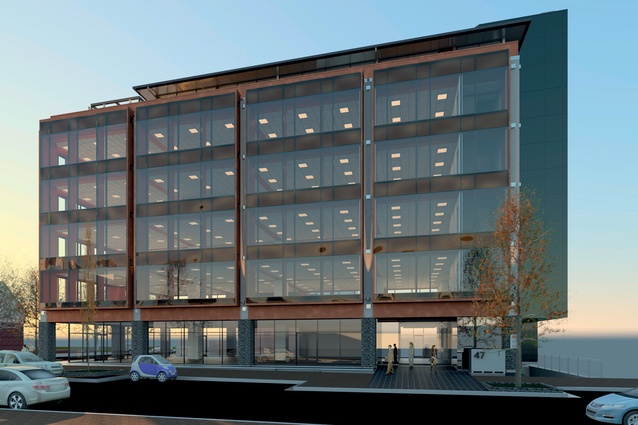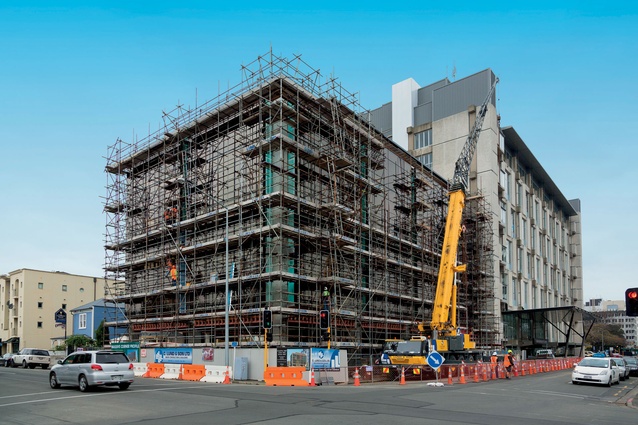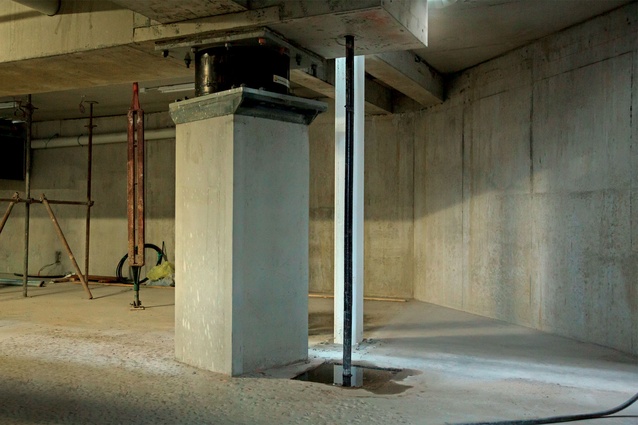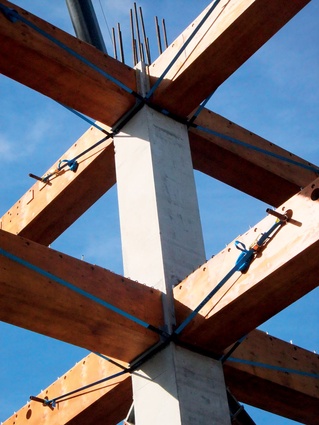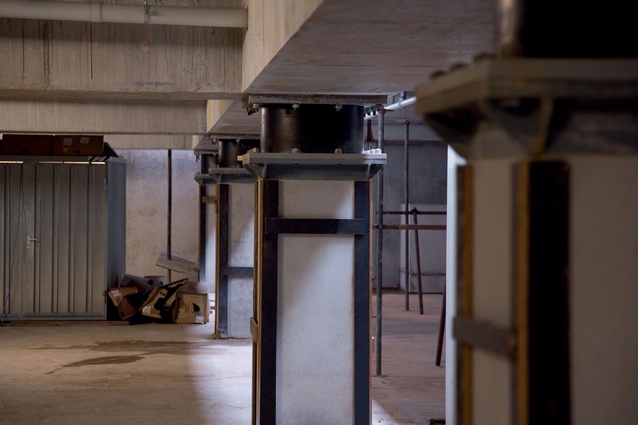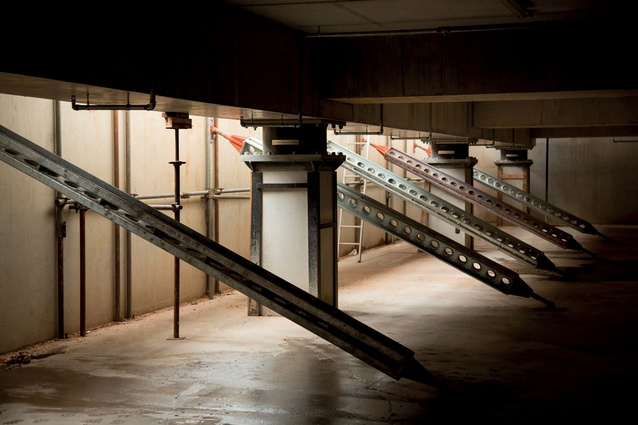Strength redefined
What is colloquially referred to as the St Elmo Courts rebuild stands rather incongruously on a corner site in central Christchurch next to the brutal concrete slabs of a Christchurch City Council building. It is one of many buildings at mid-construction point in the city, and when Progressive Building visited three sides were still covered in scaffolding.
But this building’s glazed exterior hides something of a novel engineering feat, and a world first for structural seismic technology.While all the structural elements have been used before, it is the specific combination of methods chosen for this six-level office building that make it a forerunner in the seismic engineering field.
Ruamoko Solutions engineer Grant Wilkinson said the structural design was truly unique. “It has been professionally satisfying to design a building that has several levels of innovation and is so different to other more orthodox structures,” he said.
What Wilkinson is referring to is the use of lead and rubber base isolators, tension tie downs in each corner of the building (to stop the building lifting off the base isolators), and the use of a post-tensioned frame structure of precast concrete columns and structural laminated veneer lumber (LVL) beams.
The combined use of these structural elements means the building will survive a 100 per cent Code earthquake (a 1-in-500-year event), with little or no damage to its core structure. It will withstand – that is, remain safe and stable – a 1-in-2500-year seismic event.
C Lund & Son general manager Andrew McGregor said 16 base isolated columns supported the building and four post-tensioned tie-downs – one in each corner of the building – ensure the building does not lift off the base isolators in a seismic event. The structure is built on top of a concrete raft foundation, through which the four post-tensioned tie-downs are threaded, and cast beneath the foundation into a concrete plug.
The design allows for a 400mm “rattle space” right around the perimeter of the building, which means the building is free to move 400mm in any direction in the event of an earthquake.
Because the building sits on base isolators – which will remain visible in the interior of the basement/carpark level - the lift is hung from the main structure so it can move around with it in a seismic event. It is not attached to the basement level at any point. The stairwells are also designed to move 400mm in any direction with the structure, and all services that cross to the exterior of the building are looped to allow for 400mm of movement also.
“The 16 base isolators consist of alternating layers of steel plates and rubber layers with a central lead ‘plug’ embedded in a rubber casing. The lead plug remains solid until seismic shear load across the bearing reaches such a level that the plug deforms dissipating energy [the lead shears allowing movement], while the horizontal steel plates ensure the deformation of the bearing is controlled,” McGregor said.
To ensure the compression in all base isolators is retained in a seismic event, the structural design incorporated four tension tie-downs, one in each corner of the structure. “Each tie-down consists of a post tensioned strand embedded into the ground floor of the structure [above base isolator level] and cast into a concrete plug installed five metres below the basement floor level at the base of a hollow steel caisson,” McGregor said. “The strand is free to move within the hollow caisson as the building moves on its base isolators in a seismic event.”
While liquefaction was not a concern on this site, it does sit below the water table. This meant significant drainage was required in the early phases of construction, and a unique drainage system was developed for the finished building, which incorporates two weirs on the basement/carpark level that will flood the area in an extreme event and save the main structure from damage.
Pre-cast concrete columns and LVL timber beams (which measure up to 8.7 metres in length) form the building’s unique frame. Erecting this frame provided the construction team with some of the most challenging aspects of the build, McGregor said.
The longest of the pre-cast columns measure 12 metres and extend from the ground floor slab to level three. Similar columns measuring 7.3 metres in length extend from level three to level five.
Because the beams needed to be post-tensioned horizontally on each of the grid lines, and timber beams undergo elastic shortening when a post-tensioned load is applied, McGregor said the sequence of erection and tensioning was vital to ensure the load was transferred into compression in the beams themselves, not into a bending load in the pre-cast columns, which had to remain in their exact locations for the system to be structurally sound.
“We developed a detailed step-by-step procedure that involved an initial central column being installed and grouted into position and propped with a very stiff propping system,” McGregor said. “The columns on the two perpendicular central grid lines were then erected slightly out of position (by the amount that the timber beams were expected to shorten). The beams on these grid lines for levels two and three were then erected and post-tensioned. The props were removed and the level one beams on these gridlines were installed beneath the level two beams. The bases of those columns were then finally fixed into position.”
This process was then repeated on the secondary grid lines, the beams effectively pulling the columns towards the fixed central grid line columns as they were post-tensioned.
Lining up the beams and columns so the tensioning cables could be fed through them without damage was also central to the erection of the frame. McGregor said this meant components had to be detailed to a tolerance of just 1mm.
Timberbuilt Solutions general manager Bruce Hutchings said the beams for this project were among the biggest and most complex the company had produced.
“Within the hollow box section of
the beams we had to include post-tensioning cable ducts, deviators and blocks to ensure they could be precisely located to match the ducts in the concrete columns. There were also holes for shear reinforcement, bolts and service ducts, notches … there were up to 44 separate LVL pieces in some beams and up 1300 steps to make the components for a single beam,” Hutchings said.
The untreated timber beams provided the construction team with another challenge; a lot of attention had to be paid to how water was shed during construction and how the beams were protected.
From the exterior when complete, this building will not provide any indication of its extremely high seismic capacity. However, in the basement carpark, the base isolators and tensioned tie-downs will remain visible; on the office floors the bottom of the timber beams will be visible – they will meet flush with the ceiling panels and provide an interesting ceiling grid pattern.
These visual reminders of the building’s strength are a nod, perhaps, to the history of the site and the changed, post-earthquake attitudes of Christchurch developers and tenants. The site was formerly home to the historic residential high rise, St Elmo Courts, until it suffered significant damage in 2010 and 2011 and was subsequently demolished.
The new building, to be tenanted primarily by legal firm Wynn Williams, is on track for completion in July 2014 after a 23-month build.

